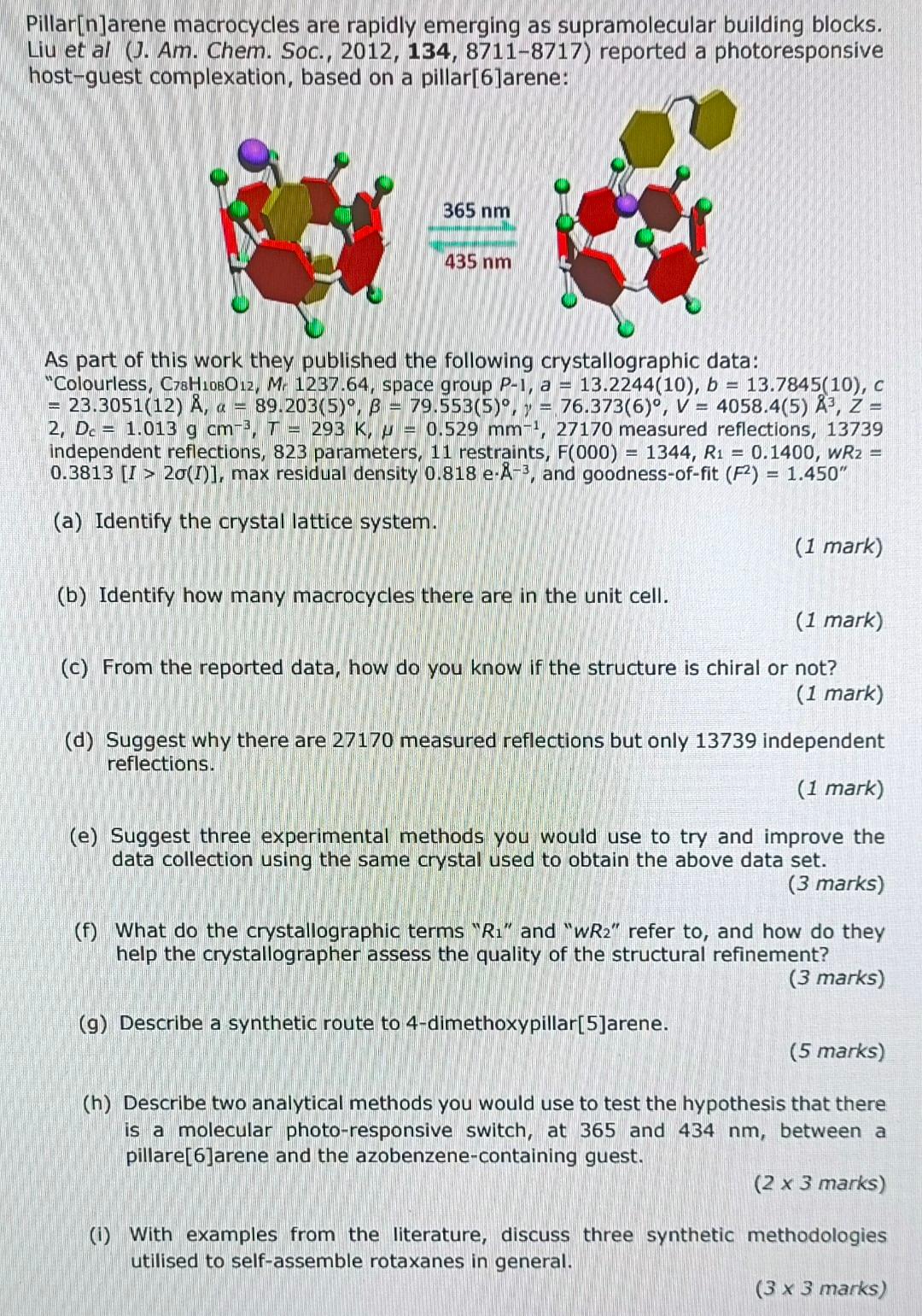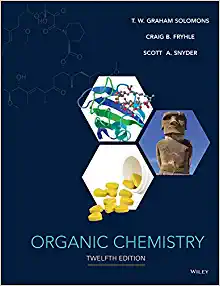Answered step by step
Verified Expert Solution
Question
1 Approved Answer
Pillar[n]arene macrocycles are rapidly emerging as supramolecular building blocks. Liu et al (J. Am. Chem. Soc., 2012, 134,8711-8717) reported a photoresponsive host-guest complexation, based on

Pillar[n]arene macrocycles are rapidly emerging as supramolecular building blocks. Liu et al (J. Am. Chem. Soc., 2012, 134,8711-8717) reported a photoresponsive host-guest complexation, based on a pillar[6]arene: As part of this work they published the following crystallographic data: "Colourless, C78H108O12,Mr1237.64, space group P1,a=13.2244(10),b=13.7845(10),c =23.3051(12)A,=89.203(5),=79.553(5),=76.373(6),v=4058.4(5)A3,Z= 2,Dc=1.013gcm3,T=293K,=0.529mm1,27170 measured reflections, 13739 independent reflections, 823 parameters, 11 restraints, F(000)=1344,R1=0.1400,wR2= 0.3813[I>2(I)], max residual density 0.818eA3, and goodness-of-fit (F2)=1.450 (a) Identify the crystal lattice system. (1 mark) (b) Identify how many macrocycles there are in the unit cell. (1 mark) (c) From the reported data, how do you know if the structure is chiral or not? (1 mark) (d) Suggest why there are 27170 measured reflections but only 13739 independent reflections. (1 mark) (e) Suggest three experimental methods you would use to try and improve the data collection using the same crystal used to obtain the above data set. (3 marks) (f) What do the crystallographic terms "R1" and " WR2 " refer to, and how do they help the crystallographer assess the quality of the structural refinement? (3 marks) (g) Describe a synthetic route to 4-dimethoxypillar[5]arene. (5 marks) (h) Describe two analytical methods you would use to test the hypothesis that there is a molecular photo-responsive switch, at 365 and 434nm, between a pillare[6]arene and the azobenzene-containing guest. ( 23 marks) (i) With examples from the literature, discuss three synthetic methodologies utilised to self-assemble rotaxanes in general. Pillar[n]arene macrocycles are rapidly emerging as supramolecular building blocks. Liu et al (J. Am. Chem. Soc., 2012, 134,8711-8717) reported a photoresponsive host-guest complexation, based on a pillar[6]arene: As part of this work they published the following crystallographic data: "Colourless, C78H108O12,Mr1237.64, space group P1,a=13.2244(10),b=13.7845(10),c =23.3051(12)A,=89.203(5),=79.553(5),=76.373(6),v=4058.4(5)A3,Z= 2,Dc=1.013gcm3,T=293K,=0.529mm1,27170 measured reflections, 13739 independent reflections, 823 parameters, 11 restraints, F(000)=1344,R1=0.1400,wR2= 0.3813[I>2(I)], max residual density 0.818eA3, and goodness-of-fit (F2)=1.450 (a) Identify the crystal lattice system. (1 mark) (b) Identify how many macrocycles there are in the unit cell. (1 mark) (c) From the reported data, how do you know if the structure is chiral or not? (1 mark) (d) Suggest why there are 27170 measured reflections but only 13739 independent reflections. (1 mark) (e) Suggest three experimental methods you would use to try and improve the data collection using the same crystal used to obtain the above data set. (3 marks) (f) What do the crystallographic terms "R1" and " WR2 " refer to, and how do they help the crystallographer assess the quality of the structural refinement? (3 marks) (g) Describe a synthetic route to 4-dimethoxypillar[5]arene. (5 marks) (h) Describe two analytical methods you would use to test the hypothesis that there is a molecular photo-responsive switch, at 365 and 434nm, between a pillare[6]arene and the azobenzene-containing guest. ( 23 marks) (i) With examples from the literature, discuss three synthetic methodologies utilised to self-assemble rotaxanes in general
Step by Step Solution
There are 3 Steps involved in it
Step: 1

Get Instant Access to Expert-Tailored Solutions
See step-by-step solutions with expert insights and AI powered tools for academic success
Step: 2

Step: 3

Ace Your Homework with AI
Get the answers you need in no time with our AI-driven, step-by-step assistance
Get Started


